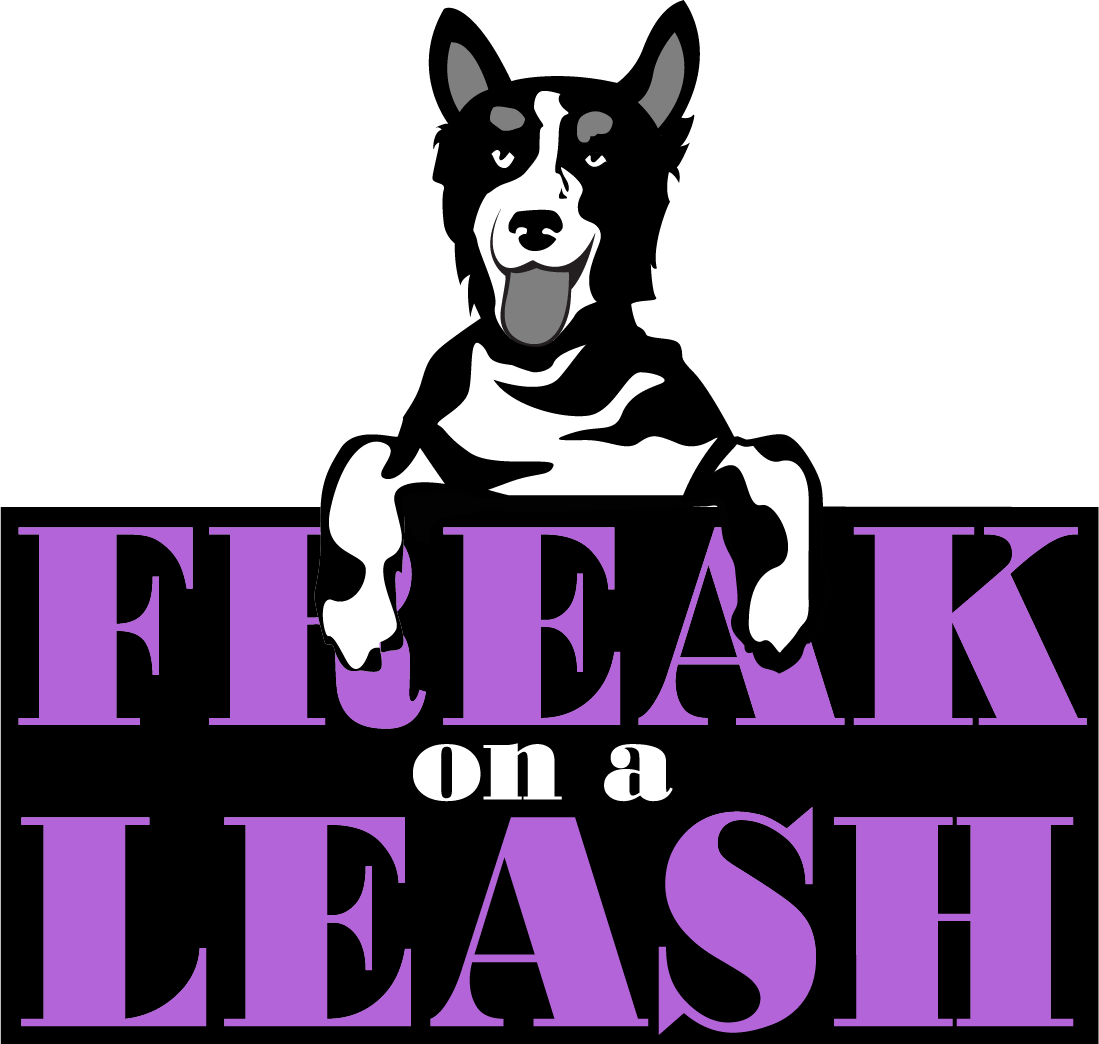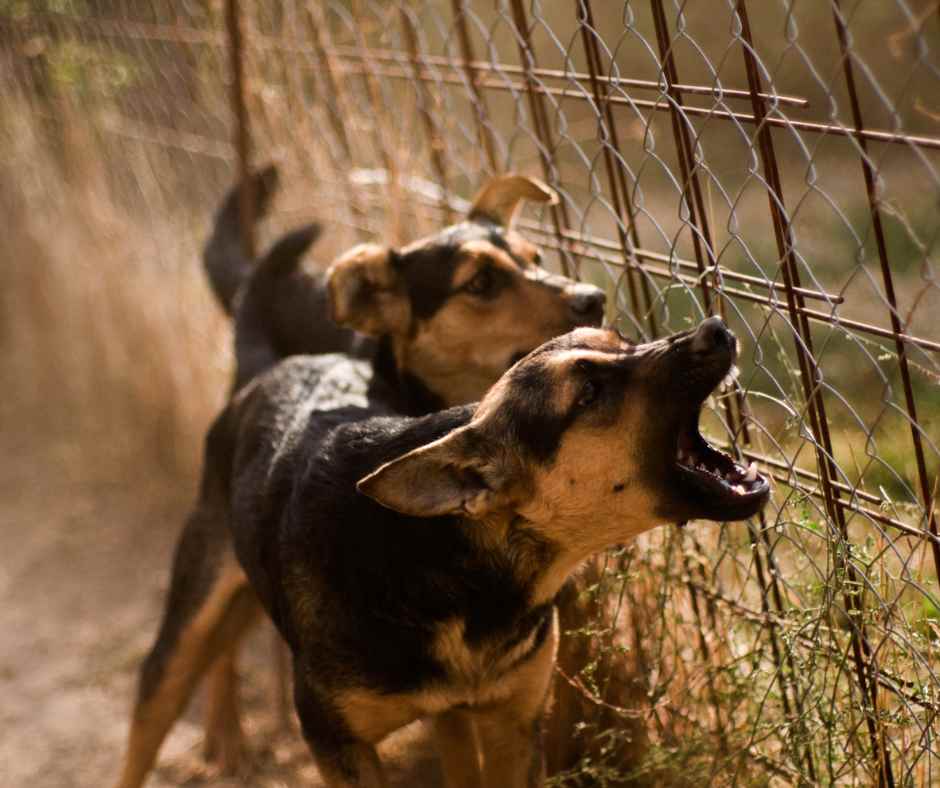Signs, Symptoms, and Causes
The most common signs of aggressive behavior in dogs include: growling, snarling, snapping, baring teeth, barking or lunging. Depending on the individual dog and situation, other body language signs may be exhibited such as a stiffened posture with raised hackles (the fur along the back of the neck), lip lifting to reveal teeth, the dog showing the whites of their eyes or retreating/cowering behavior.
It’s important to learn the signs of your dog getting uncomfortable before it escalates. See the ladder of aggression: 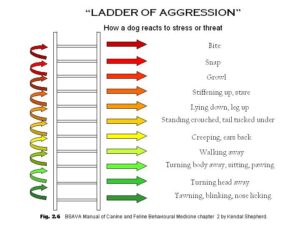
With the exception of predation, most aggressive acts are considered distance-increasing behavior: the dog is seeking to create more space between itself and the trigger. Though there are many types of aggression, fear, anxiety, conflict (uncertainty), genetics and learned responses are typically involved. Early development (prenatal and postnatal), socialization and past experience can also influence the severity of aggression. In some cases though, aggression may indicate an abnormal or pathological trait.
In order to help your pet overcome aggression it is important to seek the help of a professional. A qualified animal behaviorist or veterinary behaviorist can assess the situation and create a plan for addressing the aggression. This may include changing environmental factors, providing more exercise and mental stimulation, training exercises, and even in some cases medications to reduce underlying anxiety or frustration levels.
Different Types of Dog Aggression – Recognizing the Warning Signs
There are different types of aggression that can be seen in dogs. It is important to recognize the signs of these different types so that appropriate action can be taken and the behavior addressed.
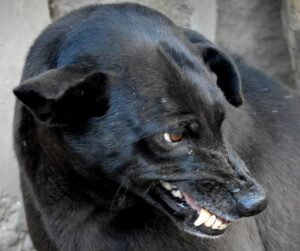 Fear-Based Aggression
Fear-Based Aggression
Fear is the root cause of most canine aggression. It is typically triggered by a perceived threat to the dog. Defensive aggression occurs as a direct response to a challenge or confrontation. In some cases, dogs may try to avoid the stimulus or trigger but become aggressive if their ability to escape is limited (e.g., by a leash or confinement), or if they have learned that aggression has been successful in the past at removing the threat. Factors such as inadequate socialization, learning, genetics (temperament), reinforcement of aggressive behavior (e.g., retreat of the stimulus) and associating negative outcomes with the stimulus (e.g., punishment) can contribute to this type of aggression. The diagnosis relies on determining signs of fear combined with identifying the history leading up to it since dogs may exhibit fear at first but later display an offensive form of aggression when they realize it works for them.
Dominance Aggression / Impulse Control Aggression
Genetic influences and early environmental experience can manifest in a range of emotional or behavioral disorders, such as fearfulness or aggression. When dogs display aggressive behavior towards family members, it’s often the consequence of past learning experiences combined with genetic predisposition and personality traits. Physical techniques such as pinning down and yelling “no” should be avoided – they are unhelpful at best, counter-productive at worst; instead socialization and positive reinforcement in the form of counter conditioning and desensitization can often form a more successful basis for relationships between canine companions and their owners.
 Territorial Aggression
Territorial Aggression
Aggression can sometimes be seen in a dog’s behavior when it is approached on its territory. Territory can be stationary (e.g. yard, home) or mobile (e.g. car). This type of aggression is distinguished by the absence of fear in response to similar stimuli outside of its territory. Fear, anxiety, defensive and possessive behaviors may all play a part, as the animal is likely to only display this type of behavior towards unfamiliar stimuli and without the motivation to flee or avoid the situation when on its own property. Learning (negative reinforcement when the stimulus retreats) and fear conditioning (unpleasant outcomes such as yelling, discipline and confinement) can also contribute.
 Possessive Aggression
Possessive Aggression
Possessive aggression is usually seen when a person or animal attempts to take something away from the dog that it desires to keep. This type of behavior is often observed in pets while they are chewing or consuming an object, but can manifest even when the dog is not actively engaging with the item. The most common triggers for this type of aggression include highly desirable food items, treats, chew toys, stolen objects and sleeping places. While genetics and early experience can play a role in the development of possessive aggression, its severity depends on how much value the pet attaches to the object and their perception of the risk of losing it to another individual or animal. Items that are novel or scarce may also be more attractive. Fearful and defensive responses may come into play if owners confront, punish or threaten their pet while they have an object in their possession or mouth, as they may realize that using aggressive behavior can help them keep hold of it.
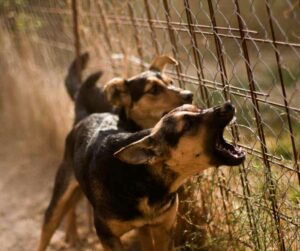 Redirected Aggression
Redirected Aggression
Redirected aggression in dogs occurs when a canine’s aggression is blocked, stopped or diverted from its original target. This commonly happens when dog owners attempt to break up a fight between two canines and the dog redirects its aggression towards them. It can also occur when a veterinary professional tries to restrain an already aggressive dog. This type of aggressive behavior emerges due to the frustration generated by interrupting or thwarting another form of aggression or arousal.
Dog to Dog Aggression
In the same household, communication is based on dominant and submissive signals, with one individual typically deferring to the other. Dominance is always relative, as the dog that usually defers can switch between resources and situations. Aggression between pets living together is often abnormal and due to fear, anxiety, redirected aggression, lack of impulse control or poor intra-specific communication skills. This can stem from either genetics or insufficient early socialization combined with experience and learning. Redirected aggression and competitive behavior over valued resources may also cause hostility among the dogs at home. Aggressive behaviors towards unfamiliar dogs tends to be fear-induced but can also be of territorial, possessive or protective in nature.
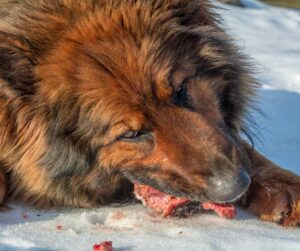 Predatory Aggression
Predatory Aggression
Predatory aggression is one of the most dangerous types of aggression since it often comes without warning signs. The intention is to kill prey, and the bite is uninhibited.
Working With an Aggressive Dog – Tips and Strategies for Training
If your pet is exhibiting any aggressive behavior, it is important to be proactive in addressing the issue and seeking help from a professional. Here are some tips and strategies for helping an aggressive dog:
• Learn as much as you can about dog body language.
• Use positive reinforcement training: Positive reinforcement focuses on rewarding desired behaviors rather than punishing undesired ones.
• Muzzle training: If your pet is exhibiting aggressive behavior, it is a great first step to teach your dog to wear a muzzle happily.
• Avoid punishment: Punishment can cause more fear or frustration in a dog that is already displaying aggression, so it is important to avoid physical or verbal punishments.
• Seek professional help: In some cases, it may be necessary to seek the help of a qualified animal behaviorist or veterinary behaviorist in order to address aggressive behavior. They can create a personalized plan for your pet and ensure that they receive appropriate treatment.
Learning how to handle an aggressive dog can be a difficult task, but with the right approach, it is possible to teach your dog the behaviors you desire. By using positive reinforcement and seeking help from a professional if needed, you can ensure that your pet receives the care they need while also creating a safe environment for everyone involved.
 Understanding Territorial Behavior and How to Manage it
Understanding Territorial Behavior and How to Manage it
When a dog displays territorial behavior, it means they are attempting to protect an area or object that they consider their own. This type of aggression can manifest itself in barking, growling, lunging, and even physical contact. To address this type of behavior, it is important to understand the root cause of the aggression and create a plan that teaches the dog acceptable behavior.
The first step in addressing territorial aggression is to identify and address triggers. By understanding what sets your pet off, you can make sure they are not placed in situations where their territorial behavior could be triggered. Once this has been identified, it’s important to use positive reinforcement training to teach them desirable alternative behaviors. This can involve rewards such as treats and praise for desired behavior, and setting boundaries so the dog learns what is acceptable and what is not.
Dealing with Fear-Based Aggression in Dogs – When to Seek Professional Help
Dogs displaying fear-based aggression are usually reacting out of fear or anxiety. This type of aggression can manifest itself in a variety of ways, such as barking, growling, and even physical contact. In these cases, it is important to be patient and understanding, as punishing the dog will only make the situation worse.
In order to help a pet displaying fear-based aggression, it is important to slowly introduce them to new environments and people in a safe and controlled manner and build their confidence. A certified behavior consultant will be able to help you find the right steps to change your dog’s emotions. Patience is necessary because overcoming fear takes time.
The Benefits of Socializing Your Dog – Setting Up for Successful Interactions with Others
Socialization doesn’t mean taking your dog into environments that are scary or unpredictable. It means taking time, being patient and using distance to increase your dog’s confidence levels. For example, instead of taking your dog to a dog park to become more confident with other dogs, hanging out far away from the dog park letting your dog watch dogs at a distance is a great way to build confidence and resilience. Take the time to slowly introduce new visitors to your fearful dog, without putting pressure on him to interact and giving lots of breaks when doing so.
Positive Reinforcement Training – What it is and How to Use it Effectively with Your Dog
Positive reinforcement training is a type of behavior modification technique used to help dogs learn desired behaviors. This type of training relies on reward-based techniques to encourage your pet to repeat desirable actions, such as giving treats or verbal praise when they display these behaviors. Positive reinforcement is an effective way to teach your pet how to act appropriately in different situations.
When using positive reinforcement training, it is important to know that reinforcement lies in the eye of the learner, just throwing food at a dog is not positive reinforcement. Every learner has a hierarchy of reinforcers. It is your job to find out what your dog finds reinforcing and is willing to change for. This is even more important in aggression cases since the stakes are higher in that there can be a risk of injury to a person or another animal.
Signs of Aggression in Dogs – Knowing When Things Get Out of Hand
The more you can learn about how your dog shows signs of fear or aggravation, the better you can predict and help him out of situations that could lead to a bite. It is important, however, not to put yourself in danger and to contact an experienced trainer, behavior consultant or veterinary behaviorist to help. These professionals are trained in looking for small subtle signs that they can show you how to recognize and mediate. By learning how your dog communicates you will be able to avoid confrontations and conflict before it spills into overt aggressive displays.
Understanding the Types of Dog Aggression – Learn to Recognize Possible Warning Signs
In order to address aggression in your pet, it is important to identify the type of aggression they’re exhibiting. Some types of aggression that can manifest in dogs are fear aggression, territorial/protection aggression, possessive aggression, and redirected aggression. Each type has its own set of signs and triggers that need to be addressed in order for the pet to feel safe and secure.
By learning the signs of aggression, understanding the triggers that can cause it, and taking steps to address these issues in a positive way, you can help create a safe environment for your pet.
 Dog aggression is a serious issue that should not be taken lightly, as it can lead to potential danger and harm. Aggression in dogs may manifest in different forms and can be caused by many factors. Knowing the signs, symptoms, underlying factors, and the different types of aggression is crucial to handling and managing this complex behavior. Everyone wants their dog to be loved, respected and happy in their environment. Dog owners should take the responsibility of understanding their pet’s behaviors – if issues appear, they will have the knowledge to bring them to light so that appropriate interventions may be proposed for the safety of both the animal and owner. Keeping an open dialogue with your veterinarian or experienced dog trainer is essential for success! Have you had a dog who displayed aggressive behaviors? How did you handle it?
Dog aggression is a serious issue that should not be taken lightly, as it can lead to potential danger and harm. Aggression in dogs may manifest in different forms and can be caused by many factors. Knowing the signs, symptoms, underlying factors, and the different types of aggression is crucial to handling and managing this complex behavior. Everyone wants their dog to be loved, respected and happy in their environment. Dog owners should take the responsibility of understanding their pet’s behaviors – if issues appear, they will have the knowledge to bring them to light so that appropriate interventions may be proposed for the safety of both the animal and owner. Keeping an open dialogue with your veterinarian or experienced dog trainer is essential for success! Have you had a dog who displayed aggressive behaviors? How did you handle it?
